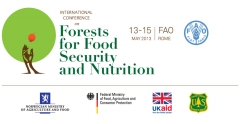Globally, millions of people depend on forests for their livelihoods – directly through the consumption and sale of foods harvested in forests, and indirectly through forest-related employment and income generation, forest ecosystem services, and forest biodiversity.

Bernard Giraud, Livelihoods CEO, presented in Rome the Araku project during the Session 9 on May 15 2013

Worldwide, 870 million people go hungry every day. With the world population projected to exceed nine billion people by 2050, global agricultural output must expand by an estimated 60 percent to meet global food needs.
Yet, in many places, deforestation triggered by escalating demand for food, fibre and fuel is degrading ecosystems, diminishing water availability and limiting the collection of fuelwood – all of which reduce food security, especially for the poor.
Natural forests are critical for the survival of forest-dwellers, including many indigenous peoples, and they help deliver clean water to agricultural lands by protecting catchments.
Farmers increase food security by retaining trees on agricultural land, by encouraging natural regeneration and by planting trees and other forest plants. For most of the year, herders in arid and semi-arid lands depend on trees as a source of fodder for their livestock.
Forests, trees and agroforestry systems contribute to food security and nutrition in many ways, but such contributions are usually poorly reflected in national development and food security strategies. Coupled with poor coordination between sectors, the net result is that forests are mostly left out of policy decisions related to food security and nutrition.
Bernard Giraud, Livelihoods CEO, presented in Rome the Araku project during the Session 9 on May 15 2013 (third speaker in the video).
The conference participants agreed that small-scale forest producers should be encouraged to strengthen their involvement in agroforestry, tree‐growing, small‐scale wood processing and the provision of ecosystem services.
The agreement of the conference sounds a lot like our vision: “Livelihoods’s mission is to support the efforts of agricultural and rural communities to live in sustainable ecosystems which serve as the foundation for their food security and provide the resources that ensure their sustainability.” This excerpt is from the Livelihoods Charter

